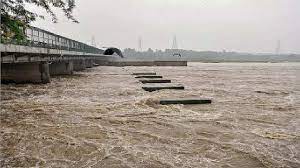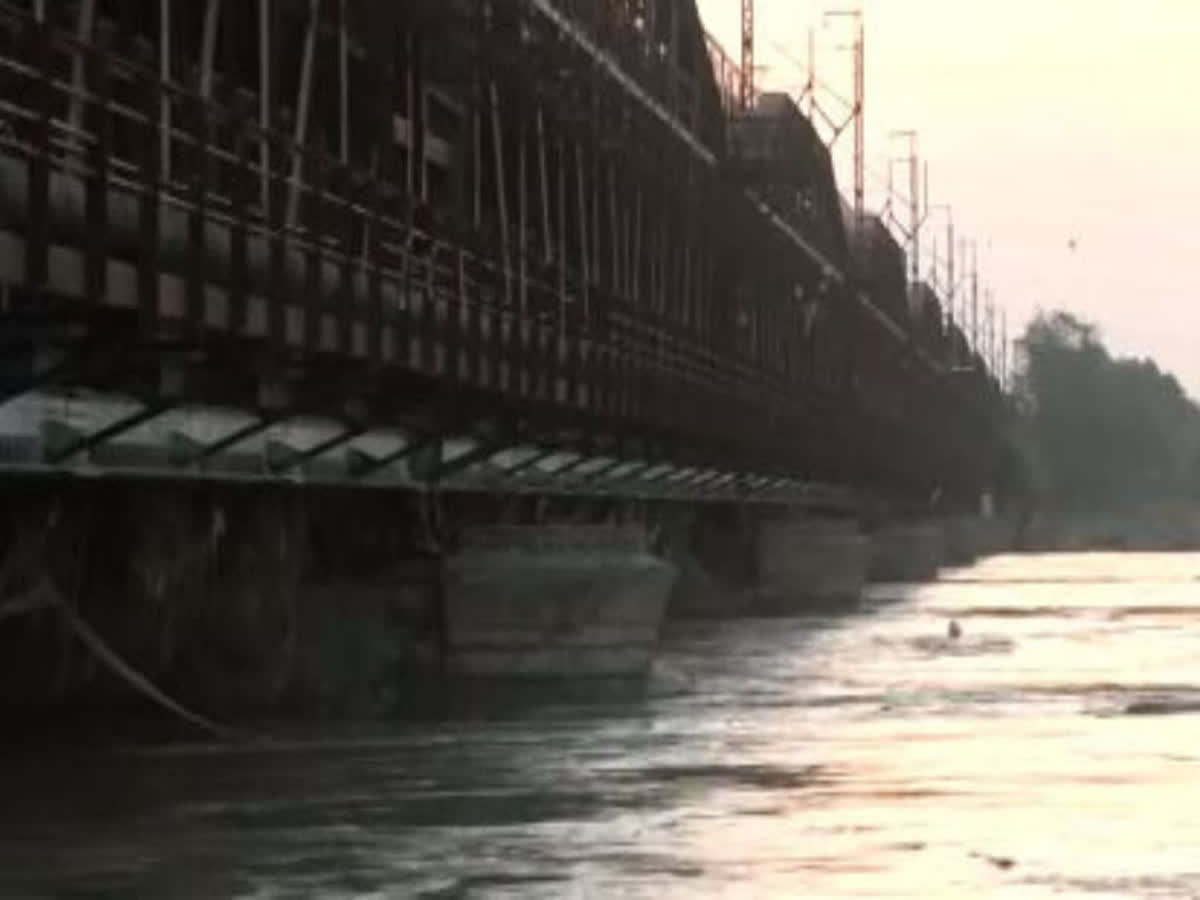Delhi: Yamuna water level dips after crossing danger mark

Delhi: Yamuna water level dips after crossing danger mark
In the capital city of Delhi, a notable downward trend in the water level of the Yamuna River has been observed on Wednesday morning. This decline comes after a temporary surge that led the river’s water level to exceed the critical mark of 205.33 meters on Tuesday. The escalation was attributed to heavy rainfall in the river’s upper catchment areas during the preceding two days.
The Yamuna River, a significant water body traversing through Delhi, is closely monitored for its water levels, especially during the monsoon season when heavy rainfall can lead to rapid fluctuations. On Tuesday, the river’s water level rose to a point beyond the danger mark, causing concerns among residents and authorities.
The Central Water Commission (CWC), tasked with tracking water levels and maintaining hydrological data, has reported that as of 8 am on Wednesday, the water level at the Old Railway Bridge stood at 205.14 meters. This indicates a subsiding trend from the previous day’s elevation.

The city’s vulnerability to variations in the Yamuna’s water level is well-known, particularly given the rapid urbanization and infrastructure development that have altered the river’s natural flow. In recent times, heavy rainfall in the river’s catchment area resulted in flooding in various parts of Delhi, with the Yamuna registering its highest-ever recorded flood level of 208.66 meters on July 13.
Moreover, the Hathnikund barrage in Haryana’s Yamunanagar district recorded a flow rate of 30,153 cusecs on the previous evening. This figure is indicative of the volume of water that the barrage handles, highlighting the significant inflow the river receives due to the incessant rains.
The situation underscores the importance of closely monitoring the water levels in the Yamuna River and being prepared for the potential impact of heavy rainfall. It also emphasizes the need for effective flood management and infrastructure development to mitigate the adverse consequences of such natural events in urban areas like Delhi.
The Yamuna River’s water level in Delhi is undergoing a reversal in its trajectory, with a descent observed on Wednesday morning. This comes after a brief period on Tuesday when the water level had surged past the critical mark of 205.33 meters. The heightened water levels were attributed to intense rainfall occurring in the upper catchment regions of the river over the course of the last two days.
The surge in water levels had led to concerns and vigilance among the authorities and residents of the capital city. The situation had been closely monitored due to the potential risks associated with flooding and the safety of the local populace.
As per data provided by the Central Water Commission (CWC), the water level recorded at the Old Railway Bridge had reached 205.14 meters at 8 am on Wednesday. This data suggests a decline in the water level compared to the previous day when it surpassed the danger mark. The decrease in water level is a reassuring sign for the city as it indicates a reduction in the flood risk that had been anticipated due to the swelling of the river.
The Central Water Commission is an authoritative body responsible for monitoring and assessing the water resources and river systems across the country. Their monitoring and reporting of the Yamuna River’s water levels play a pivotal role in offering timely information to the relevant authorities and the public, allowing them to take necessary precautions and actions in response to changing water conditions.
The fluctuating water levels of the Yamuna River highlight the intricate balance between natural forces and human interventions in water management. The impact of rainfall, upstream activities, and weather patterns collectively influence the water levels in rivers, necessitating vigilant monitoring and preparedness in regions prone to such fluctuations.

As the water level continues to be tracked and managed, the safety and well-being of the citizens of Delhi remain a paramount concern, and timely information from organizations like the Central Water Commission plays a crucial role in ensuring their security.
Just a month prior, the national capital faced the repercussions of intense rainfall within the river’s catchment region, resulting in widespread flooding across various areas. The Yamuna River had surged to unprecedented levels on July 13, reaching a historic flood level of 208.66 meters, setting a record for the highest flood level ever recorded.
In addition, the Hathnikund barrage situated in Haryana’s Yamunanagar district had witnessed a substantial flow rate of 30,153 cubic feet per second (cusecs) on the previous evening. The flow rate measurement is a critical indicator of the volume of water passing through the barrage and provides valuable insights into the water dynamics of the river.
The combination of heavy rainfall in the catchment area and the flow rates at the Hathnikund barrage underscore the dynamic and complex nature of river systems, where multiple factors interplay to determine water levels and flood risks. The recent occurrences of flooding and heightened water levels serve as a reminder of the susceptibility of regions like Delhi to the impacts of heavy rainfall and the subsequent consequences for river levels and local communities.
The monitoring and documentation of water levels, flood records, and flow rates are essential aspects of river management and disaster preparedness. They facilitate informed decision-making, timely alerts, and effective responses to changing water conditions. As the Yamuna River continues to respond to the varying patterns of rainfall and upstream activities, vigilance remains crucial to ensuring the safety, well-being, and resilience of the residents in the regions that the river traverses.
The relentless downpour in Uttarakhand and Himachal Pradesh has triggered a rapid surge in the water levels of rivers, creating a situation of concern, according to reports from ANI.
The persistent rainfall continues to cause havoc in both Himachal Pradesh and Uttarakhand. In the midst of incessant downpours, the Indian Meteorological Department (IMD) has sounded a ‘red alert’ for numerous areas across these states, predicting the occurrence of ‘heavy to very heavy rains’ over the next 24 hours.
The IMD further noted that the ‘red alert’ will subsequently transition into an ‘orange alert,’ indicating a slightly reduced intensity of rainfall. The mountainous regions have been witnessing a series of unfortunate incidents due to unrelenting rainfalls. In Himachal Pradesh alone, the toll of casualties resulting from the past two days of heavy rains has surged to 55. The occurrences of landslides, flash floods, and cloudbursts are causing severe loss of lives, substantial property damage, and the displacement of residents.
The ongoing weather conditions serve as a grim reminder of the vulnerability of hilly regions to the impacts of heavy rains and the associated disasters they bring about. The issuance of alerts by meteorological authorities plays a pivotal role in keeping communities informed and enabling them to take precautionary measures in the face of such inclement weather patterns. As these states grapple with the aftermath of these natural calamities, attention remains on minimizing further damage and ensuring the safety and well-being of the affected population.
The devastating impact of heavy rains in the region has resulted in a tragic loss of approximately 55 lives in Himachal Pradesh. However, the toll is feared to increase as rescue and recovery operations continue. Chief Minister Sukhvinder Singh Sukhu has emphasized the urgency of restoration efforts, with a focus on rescuing individuals who remain trapped due to the calamity.

Notably, the Chandigarh-Shimla 4-lane highway, along with other key roads, has been cleared and is accessible. Although progress is being made on the main roads, it is anticipated that state roads will take more time to become fully operational, indicating the extensive nature of the damage.
Rishikesh, in Uttarakhand, has also suffered significant casualties, with three individuals losing their lives and ten others reported missing in rain-related incidents. The city experienced the highest volume of rainfall in the entire country on Monday, underscoring the severity of the weather conditions.
Further intensifying the distress, the town of Joshimath in Uttarakhand has encountered fresh concerns as new cracks have emerged due to the heavy rains, creating heightened anxiety among the residents.
The essential connectivity of major highways in hilly areas, such as Kalka-Shimla, Kiratpur-Manali, Pathankot-Mandi, and Dharamshala-Shimla, has been severely disrupted by the relentless downpours. This situation has contributed to the blockage of these crucial routes, underscoring the broader challenges posed by the ongoing weather turmoil.
As the affected regions grapple with the aftermath of these calamitous weather events, the paramount focus remains on saving lives, providing aid to those in need, and facilitating the restoration of vital infrastructure. The urgency of the situation necessitates a coordinated response from authorities, communities, and relief agencies to ensure the safety and well-being of those affected by these unfortunate circumstances.




